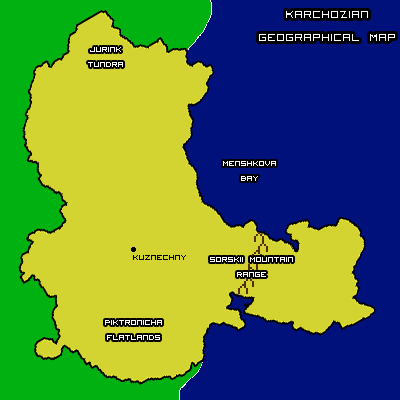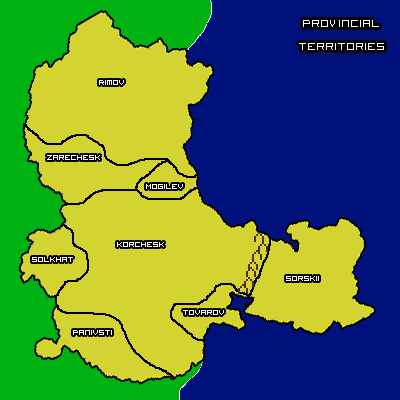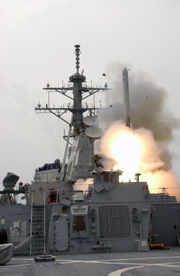Karchozia
| |||||
| Motto: "With Unity there is Strength" | |||||
| National Anthem: March, March, Karchozia! | |||||
| See Geography section for map | |||||
| Region | Rogue Alliance | ||||
|---|---|---|---|---|---|
| Capital | Kuznechny | ||||
| Largest city | Kuznechny | ||||
| Official Language(s) | English, Russian, Polish | ||||
| Government | |||||
| - Prime Minister | Vasil D'Anglas | ||||
| Ancient Alliance | 18th century | ||||
| Population | 2.7 Billion | ||||
| Currency | Chosia (KRC)
| ||||
| Internet TLD | .ka | ||||
| Calling code | +0891
| ||||
| ISO Code | KARC
| ||||
| NS Sunset XML | |||||
Also known as Karchosia, the founder of the Rogue Alliance. The creation of Karchozia as a unified state did not occur until March 3rd, 1784 (Karchozian Calendar), after a fierce internal civil war. After many rulers, the current political structure of Karchozia is that of a republic, with a Prime Minister at the head of political affairs.
History
Karchozia was formed from the shattered remnants of eight separate war-torn provinces, which formed an alliance in 1257 (K.C.) to fight off invading civilizations. However, the provinces shared no political relations with each other, limiting themselves to a general military alliance. This alliance was able to hold onto it's borders until 1329, when a new nomadic tribe made successful military ventures into their borders. The provinces were slowly whittled away, and were forced to declare governments in exile in the central province of Korchesk. It was at the capitol city of Kuznechny that the last defense was thrown up in the face of the nomads. During the Battle of Kuznechny, the nomadic tribesmen were defeated through the brilliance of Kuznechny's garrison commander, Vlastislav Puntikan. Following the defeat of the nomads, Vlastislav declared a new alliance of the provinces. The Ochakov Alliance (1342), named after the city it was signed in, now bound the seven provinces (Mogilev is not yet independent) together in a political, as well as military, alliance. The governments now operated out of the new capitol city of Kuznechny.
The Ochakov Alliance lasted well into the late 1430's, but a rough series of conflicting political ideals from the provincial leaders started to create a widening chasm between the provinces. In the late 1450'a, the provinces of Rimov and Sorskii fell into trade disputes over the natural resources, and this eventually led to military conflict. The other provinces had no choice but to become involved, due to their close proximities, and a civil war erupted. This managed to effectively dissolve the Ochakov Alliance. Between 1460 and 1486, there were sporadic episodes of fierce fighting. After 1486, the fighting lessened as the provinces attempted to bring about an agreeable peace treaty. The terms were not satisfactory for Rimov, who continued their military operations towards the capitol of Sorskii.
Only the assassination of King Vladislav II brought about the end of the Rimov-Sorskii War, as the far more pacifistic Prince Favst VII took the throne of Rimov in 1503. However, a new problem now presented itself to the provincial states. During their decades of fighting, their nations passed by multiple opportunities to modernize many facets of their society. Sorskii was the first territory to begin to vigorously modernize their economy, military, and society. They proved to be an excellent example, and the other regions followed suit. Modernization also had it's drawbacks: Tovarov felt it had an economic rival, and imposed a crude blockade of the Sorskii peninsula. Once again, the region fell into ruin and chaos as the provinces settled new grudges and attempted to sabotage other modernization attempts. This period of anarchy is referred to as the War of the West (after the influential Western travelers who brought their ideas which sparked the rapid modernization), which occured between 1523 and 1597.
In 1597, peace spontaneously broke out across the region. It was during this time that a new language was becoming instituted around schools in each of the seven provinces. English was quickly becoming the new merchant language, as regions such as Tovarov were quickly becoming populated with Western travelers and merchants. And in 1628, Korchesk declared English to be among their primary languages (Russian being the other). A Cultural Revolution shook the area, as new ideas and styles were introduced to the common man. Art forms, music, writing. Literacy was on the rise. This century-long period of time (lasting between 1616 and 1712) is called the Golden Awakening among the Karchozian elite.
On April 23, 1723, war broke out again. A large group of peasants and merchants in the eastern quarter of Zarechesk had declared a newly independent state. This unprecedented event would eventually lead to the founding of Karchozia. Zarechesk quickly moved in their military to put down the rebellion and reclaim its territory. Korchesk, seizing the opportunity to end the threat of dictatorship, entered on the side of the newly formed Mogilev in 1724. When Zarechesk was finally put down in 1778, it was realized that something more permanent must be done. Government officials from each of the territories met in Kuznechny to discuss what must be done. Over the next five years, they discussed and debated various proposals for a long-lasting peace. Sutrika Vladimir, a delegate from Panivtsi proposed a unified country under one governmental system. Exactly one year from that day, on March 3rd 1784, Karchozia officially ratified it's first Constitution and became a unified state.
From that period on, over the last 220 years, Karchozia experienced rapid modernization, especially militarily, and worked out the kinks in it's government. They are currently the head of a regional alliance known simply as the Rogue Alliance. Karchozia has also been aggressively active in other international affairs. In recent years, they have come into conflict with the massive nation of Entsteig. Having formed an alliance with another nation, Jaghur, they attempted to take on the powerful armies of the Steigian government. Their attempt was doomed for failure from the start, and a political coup attempt was made at Kuznechny. The government ground to a halt as they tried to sort out the anarchy.
Finally, officials from the old government were able to revive the government and the nation was able to get back on its feet. Vasil D'Anglas, a citizen of the nation of Sienska, was given reins of the Karchozian Parliament. It was a first in the history of the nation that a foreign-born citizen had held such a powerful position. He has pursued a policy of cooperation and non-aggression, although it has not always been possible at all times.
Very recently, Karchozia and her allies have concluded a year-long war with the Rogue Union. The Rogue War resulted in the dissolution of the Rogue Union and a resounding victory for Rogue Alliance. The military power of the Alliance has once again been proven in a most extravagent manner.
Provincial History
Panivtsi- The oldest province, founded in the 10th century. Throughout its entire existence it was ruled by a monarch from the Liprishka bloodline.
Rimov- Rimov was the largest province until the formation of Korchesk. Rimov was controlled by a small assembly of noble elites since it's creation in 1053 until 1147, when it became a monarchy.
Korchesk- The central-most province, Korchesk is the home of Kuznechny. It had been a parlaimentary republic since its formation in the late 13th century.
Mogilev- Mogilev, founded in 1723, was a small breakaway state from Zarechesk. The Mogilev Rebellion is still a symbol for freedom from oppression throughout Karchozia.
Sorskii- Sorskii was the primary source of minerals and wood for the entire region. Even to this day, the area that used to be Sorskii is rich in natural resources. They have maintained a stable, centralized democratic system since their creation in 1408.
Tovarov- Founded in 1190, Tovarov was the only province to have no centralized governmental system. It's primary purpose was to serve as a trading hub for travelling merchants. It was named after Alexei Tovarov, who built the first merchant town there in 1172.
Zarechesk- The smallest of the eight provinces in terms of land mass and population. They citizens of Zarechesk were ruled by a steady stream of hard-lining, tyrannical dictators up until the formation of Karchozia.
Solkhat- Solkhat is famed for being the only province to have been an empire before the Ochakov Alliance. It was created in 1026 by Emporeror Iosef Yurinpotchki.
Politics
[[image: |thumb|Vasil D'Anglas is the first foreign-born Prime Minister in Karchozia's history.]] The political system of Karchozia has been a democractic republic throughout its existance, although almost all of the Prime Ministers have been in the Karchosian Diplomatic Corps at one time. The current Prime Minister, Vasil D'Anglas, is the first foreign-born citizen to hold the rank of both Prime Minister and be the President of the Karchozian Diplomatic Corps (KDC). The government is composed of three distinct branches:
Judicial- The House of Law is the primary operator of the judicial branch. Members of the House of Law have the full power of the Karchozian Constitution at the backs. It is the job of these twelve members to pass judgment on any: 1) Revisions to the Constitution, 2) Cases of a Sensitive or Important Nature, or 3) Appointment of a New Prime Minister (this has not occured yet).
Legislative- The Karchozian Parliament is made of up 100 individuals elected to create and approve laws. Each official is allowed as many terms as they wish, and elections are held every two years. Currently, the Parliament is a Liberal majority.
Executive- The Prime Minister of Karchozia has the authority to declare war (with Parliamentary approval), veto bills, and make fancy speeches. The current Prime Minister, Vasil D'Anglas, has pursued an extremely hands-on approach to his foreign relations with other countries, undoubtedly stemming from his training in the Karchozian Diplomatic Corps.
Geography


Economy
The powerful national economy is Karchozia's lifeblood. The current Gross Domestic Product is $63,973,965,557,483.27 , and the Chosia is beating out the dollar at an exchange rate of $1 Chosia = $1.2136 USD
The government of Karchozia gears its economy towards the defence of its country. About 43% of its annual budget goes to the military. At last count, this equates to approximatly $12,897,301,367,059.20 USD. The next highest government priority is Commerce, at 16%, and Law & Order, at 15%.
The Gross Domestic Product (GDP) per Capita is $23,799.84, and there is currently a modest trade deficit. The national unemployement rate is 3.29%.
Demographics
Population
As of the last national census, the population of Karchozia was approxiamatly 2,552,000,000 citizens. Of this group, 3.29% are unemployed. The amount living beneath the poverty level is about 5.32%, while the extreme upper-class accounts for 2.79% of the population. [[Image:|thumb|Karchozia is home to sprawling metropolis', as seen in this artists depiction of Korchesk's east side.]]
Ethnicity
With regards to the Russian heritage of Karchozia, a modest amount of the citizens have Russian ties. 43% are of Russian descent, 21% are Anglo-Saxon, 16% have French blood, 12% are of South Pacific birth, and 8% are German.
Language
Karchozia was predominantly a Russian state throughout much of its early existence, thus, there is an abundance of Russian cultural influences. However, the introduction of Western traders caused English to become the primary language. Russian is still heavily taught as an elective course in Karchozian schools, along with a smattering of other international dialects. French and German are two other commonly heard languages.
Religion
As there is no census taken for religious beliefs, much is left to speculation. However, based on religious institutions present and the attendence of such institutes, it is possible to theorize a basic estimate of religion throughout Karchozia. 69% follow a Christian religious order, the majority Protestant. 10% are Islamic, with another 10% declaring themselves atheist.7% are Jewish, and the remaining 3% follow radicalized cults.
Military
Widely recognized in the international scene, the Karchozian military is a well-funded and powerful force. The mere funding for all military personell and vehicles accounts for almost half of Karchozia's substantial spending amount.
Army
The pride and joy of all the Armed Forces, and the most funded, the Karchozian Army (KA) is the best of the best. General Iosif Kuropatkin commands all aspects of the army. This also includes the training of the Karchozian Marines, but they are then shifted to the Naval command structure. The Karchozian Royal Ground Forces, as is their historical title, also is in control of mechanized ground forces, as well as the infantry, and other ground units. The KA is currently experiencing its highest enlistment since its establishment, mainly due to the recent success of the Rogue War, and it is still growing at a phenomenal rate. The Royal Ground Forces as a whole is increasing a steady amount in terms of recruits and units. Karchozian Ground Technologies (KGT) is Karchozia's main supplier of tanks, troops transports, and other military vehicles utilized by the Royal Ground Forces.
Current Statistics
3.6 million personnel (active)
2.0 million reservists,
350,000 Main Battle Tanks (various designs),
1 million Armored Personnel Carriers (various designs),
200,000 Artillery Pieces,
500,000 Heavy Ground Weapons (howitzers, anti-tank, etc)
Weapons and Units
The infantry units of the Karchozian Army are armed with the highly versatile KM-40 All-Purpose Weapon, which can be equipped with a variety attachments to change its role in seconds. Attachments include: Sniper, Machine Gun, Sub-Machine Gun, Rifle, Grenade Launcher. Their side-arm is a modified variant of the Walther P99.
The Main Battle Tank (MBT) of the Karchozian Ground Forces is the powerhouse KGT-M6B2.
-125mm Turret Gun
-7.62-mm Coaxial Machine Gun
-46.5 Metric Tons
-Road Speed: 65 km/h
-Cross-Country Speed: 45 km/h
-550 - 650 km Range
-43 Transportable Rounds
-Armor Volume: 11.04 m3
Its sheer power clears the battlefield of enemy combatants.
Almost 1/2 of Karchozia is coastline, making it imperative that there is an adequate naval force capable of defending it. Admiral Fredrick Nvast is the current Commander in Chief of Karchozian Naval Forces (CCKNF). During the course of his time in office, he has increased spending on various aircraft carrier designs and destroyer support craft. He has also authorized the construction of a new nuclear submarine class, which will recieve the title of Volskilav. A precise count of current naval units in confidential under the "Karchozian Espionage Act", which restricts the amount of knowledge the public has on sensitive military material. However, number ranges have been provided by the Karchozian Office of Naval Affairs, although their accuracy is disputed.
Current Statistics
12-20 Aircraft Carriers,
200-275 ********-class Destroyers,
2-11 Volskilav Submarines,
24-33 Nabokov Submarines,
155-200 ******* Cruisers,
X Support Craft,
X Classified Naval Warships
Units
The Volskilav Nuclear Attack Submarine is to be the most advanced to date. It will combine the latest in ballistic missile technology with the most accurate radar systems. It's prowling mass won't even be heard beneath the waves.
Displacement: 7800 tons
Length: 114.9 m (377 ft)
Beam: 10.3 m (34 ft)
Propulsion: S9G reactor
Air Force
The least-funded branch of the Karchozian Armed Forces, the Karchozian Air Force (KAF) is forced to rely on technological superiority rather than numerical superiority. However, the term 'quality over quantity' has greatly aided the fighting prowess of the KAF. Currently commanded by Air Marshal Pavil Yentivosk, the KAF have made attempts to increase their funding, but no decisions have been announced. The KAF's primary function is to patrol the skies of Karchozia, and protect key civilian and military installations. They provide basic air cover during military operations, but due to their lack of numbers, they cannot perform any large-scale military actions independently. However, they managed to prove that they were capable in their own right in various arieal dogfights during the Rogue War.

Current Statistics
71 KB-3 Panivtsi
53 KF-19 Manticore
52 KB-2A Slovenski
68 KF-14 Tyrant
21 KJ-1 Neovit
170 KF-3 Tsarkov
75 KB-1 Sturmovich
210 KFH-21B Molotov
X Support Craft
Units
The KJ-1 Neovit is the newest jet fighter to be introduced into the KAF. While its numbers may be small, they are extremely powerful aircraft in the right hands. Its combination of agility, performance, stealth features and advanced avionics make it one of the most capable fighter aircraft currently in service.
Crew: 1 or 2
Length: 15.96 m (52 ft 5 in)
Wingspan: 10.95 m (35 ft 11 in)
Height: 5.28 m (17 ft 4 in)
Wing area: 50 m² (540 ft²)
Empty weight: 11 000 kg (24,250 lb)
Loaded weight: 15 550 kg (34,280 lb)
Max takeoff weight: 23 500 kg (51,809 lb)
Powerplant: 2× Karchozi KJ200 afterburning turbofans, 60 kN dry, 90 kN with afterburner (13,500 lbf / 20,250 lbf) each



